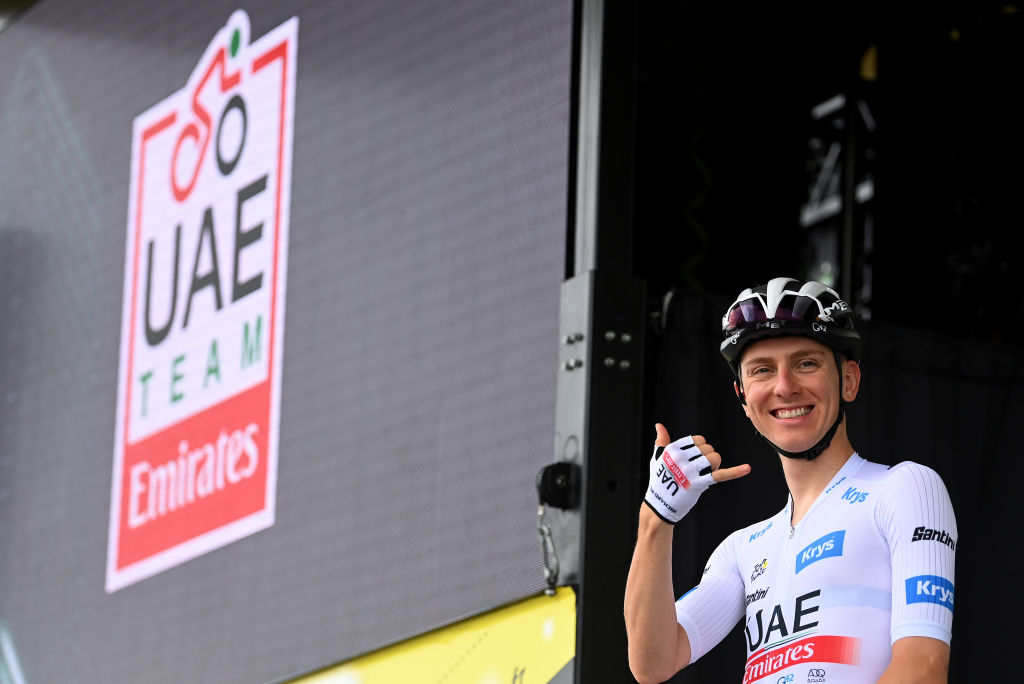'It's just cooling, nothing fancy' - Tadej Pogacar's rapid Tour de France ice bath
UAE Team Emirates says post-stage routine is 'more for the head' than for recovery

Nothing ever goes unnoticed at the Tour de France, and so when Tadej Pogačar ducked into a UAE Team Emirates van immediately after stage 1 in Bilbao, a huddle of cameras quickly formed outside.
The Slovenian emerged barely a minute later, having apparently taken a very rapid ice bath before making his way to the podium ceremony to accept the white jersey of best young rider.
Pogačar had already snaffled four bonus seconds for taking third on a stage won by UAE Team Emirates companion Adam Yates, thus stealing an early march on Jonas Vingegaard and Jumbo-Visma. Some were quick to couch this as another blow against their rivals.
"This probably sets a new standard in an arms race for even more optimal ways to recuperate,” Jan Bakelants said on Sporza’s 'Vive Le Vélo' show, speculating that Pogačar might have availed of a form of cryotherapy. “They may be too quick for Jumbo-Visma with this.”
Speaking to Cyclingnews and Het Laatste Nieuws at the start of stage 2 in Vitoria, however, UAE Team Emirates medical director Adriano Rotunno downplayed any notion of the ice bath being a so-called marginal gain, explaining that Pogacar had simply looked to cool down after the stage.
“It’s just simple cooling with an ice bath, nothing fancy,” Rotunno said, who added that the practice was aimed at comfort rather than recovery. He also pointed out that a longer ice bath would cause more harm than good in the immediate aftermath of a stage.
“We’re not using prolonged submersion because that’s for sure proven to be non-beneficial to recovery and performance. It’s purely to cool down body temperature. It’s an acute submersion, we go in and out for less than a minute at a healthy temperature.
Get The Leadout Newsletter
The latest race content, interviews, features, reviews and expert buying guides, direct to your inbox!
“It’s not intended for recovery or performance but it’s more based on just allowing the rider to feel better after the stage. We don’t do prolonged submersions, because the longer the submersion, the more deleterious it is to performance. We follow performance-based evidence in this team, and we’re doing it purely as a request from the riders.”
The temperature of the bath, Rotunno continued, is chilled rather than freezing. “It depends on the ambient temperature and where we are, but evidence shows that between 10 and 15 degrees is probably your safest range.”
When Pogačar sat into the van in Bilbao on Saturday, a UAE Team Emirates soigneur could be seen admonishing a reporter who was attempting to film him. The idea, Rotunno insisted, was simply to save Pogačar’s modesty rather than keep a cutting-edge recovery technique out of public view.
“We’re doing it in the van purely out of respect for the privacy of the riders, we’re not trying to hide anything,” Rotunno said. “I’m being as transparent as I can here. It’s purely from a privacy perspective. I wouldn’t want to sit half-naked in a bath with people watching me, to be honest.”
UAE head of performance and Vitoria native Iñigo San Millán echoed Rotunno’s words, maintaining that the benefits of Pogačar's ice bath were as much psychological as physical.
“It is more for the head. After the finish, there’s the podium ceremony, and he doesn’t have time to take a cold shower and relax, so this is – boom – in and out,” San Millán said. “It’s a marginal gain, but it’s nothing special. It’s just an ice bath.”
Team manager Mauro Gianetti, meanwhile, explained that it was Pogačar himself who had requested the ice bath. The two-time Tour winner has never made any secret of his preference for racing in colder temperatures over the white heat of July. “He specifically asked us for it for all the stages of the Tour, but if the other riders on the team want to use it, it’s no problem,” Gianetti told BiciSport.

Stephen is one of the most experienced member of the Cyclingnews team, having reported on professional cycling since 1994. He has been Head of News at Cyclingnews since 2022, before which he held the position of European editor since 2012 and previously worked for Reuters, Shift Active Media, and CyclingWeekly, among other publications.